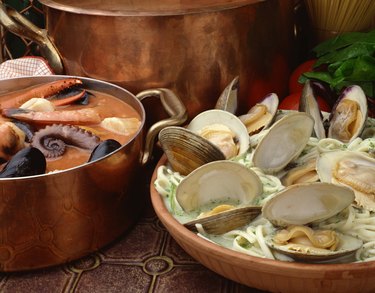
Many delicious pasta dishes call for a sauce made with white wine. For a successful meal, you have to do more than pour cooking wine over boiled spaghetti. Add white wine early on in the cooking process to balance it against other ingredients and create the best flavor in your final product.
Type of Wine
Video of the Day
Despite their name, cooking wines are not a good choice for cooking anything -- including sauces for pasta. Cooking wines are usually made from a cheap base wine with added salt and food coloring. You should always select a drinkable wine for cooking. When you prepare a pasta dish using wine, you usually let it reduce -- intensifying the flavors. If you use a poor-tasting wine, you'll end up with a poor-tasting dish. "Cooking Light" magazine says that a quality American sauvignon blanc is the best choice for almost any recipe calling for white wine. If you are preparing a recipe from a particular region, opt for a white wine from that region for your pasta dish.
Video of the Day
Deglazing
For pasta dishes including white wine, create the sauce in a separate pan. Cook any aromatics -- such as onions, garlic, carrots and celery -- in butter or oil first. Once browned, use the white wine to deglaze the pan -- scraping up browned bits that have formed on the bottom to add flavor to the dish. Recipes rarely call for you to add wine late in the cooking process as it can make the pasta dish taste too much like alcohol.
Reduction
After you add the wine, allow it to reduce by about half -- or as much as your recipe indicates. Cooking the wine helps decrease the amount of alcohol in the final product. It also mellows the flavor and prevents the sauce from being too thin. White wine is only one flavor in your pasta dish. You don't want it to overwhelm the other ingredients. Once it is reduced, add in the other liquid ingredients such as broth or cream.
Proteins and Vegetables
If your dish includes a long-cooking vegetable or protein, such as roasted red peppers or chicken, precook those items. Don't cook these items in the wine itself as they will soak up the flavor and have a sour, alcohol-like taste. Cooking vegetables in wine can dry them out, making a poorly textured final dish. Add them in the final steps as the sauce simmers so the flavors can meld. If you are adding a quick-cooking protein or vegetable, such as shellfish, clams or frozen peas, you do not have to precook them. Add the cooked pasta last; you do not want it to sit in the sauce too long because it could become mushy.